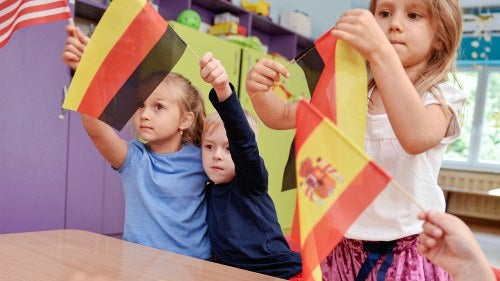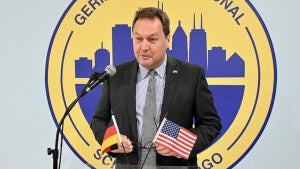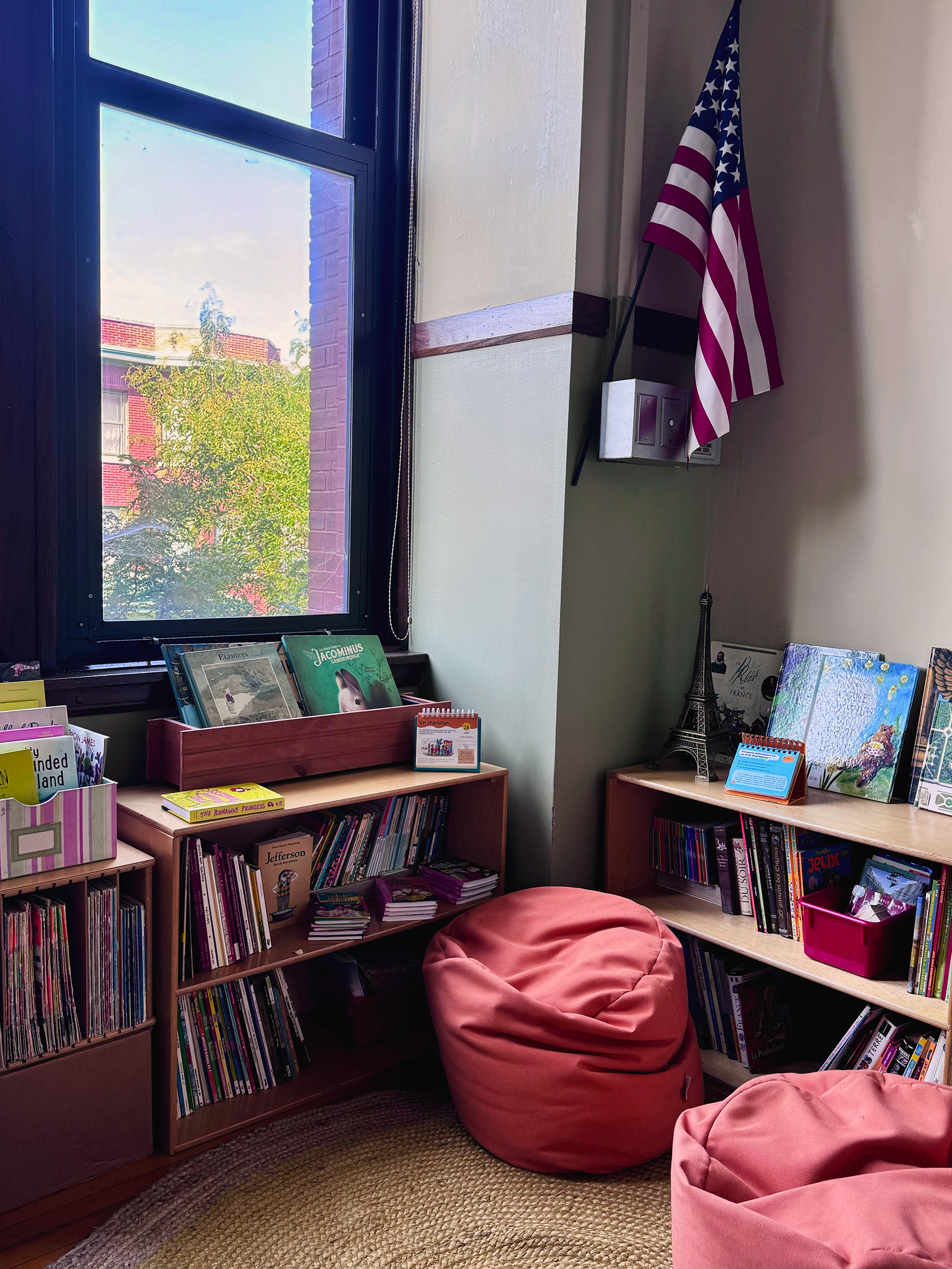What's the Value of an International Education in Chicago?

Across the city, schools that use curricula from foreign countries give a unique edge to K-12 students seeking a globally diverse education.
When her oldest child reached school age, Sabrina Pierrard started to shop for options. She liked her local public school in Ravenswood, but she and her husband were also curious about two nearby international schools.
Pierrard — who has often traveled internationally for work — recalled that she “always felt a little behind” when she met people abroad who could speak multiple languages. A bilingual education stood out as an appealing option for her children, especially since her husband was bilingual, too, having grown up speaking Greek.
Now, Pierrard sends all three of her children to the German International School of Chicago, where she’s become a member of the board. The school has grown dramatically in the last 15 years, fueled in part by families by Pierrard’s: Since 2008, enrollment has increased from 13 students, all preschool-aged, to 180 students in grades K-8. School leadership now plans to launch a high school and graduate its first class in 2030.
While Chicago doesn’t have as many international schools as coastal cities like New York and San Francisco, the Windy City is an emerging hub for K-12 international education. Though tuition costs — which can range from about $20,000 to $40,000 — are prohibitive for many families, strong enrollment across several schools suggests that Chicagoans do see value in international schooling.
What’s Different About an International Education?
Several Chicago-area schools, including over 20 in the Chicago Public Schools system, offer diplomas from the International Baccalaureate Organization, which are accepted for admissions by universities in over 100 countries.
A much smaller subset of schools, though, are accredited by foreign governments and align their curriculum with both American educational standards and those set by the education departments of their partner nations. These include the Lycée Français de Chicago, two British International School campuses, the French American School of Chicago, and the German International School of Chicago.
According to Benjamin Hebebrand, director of the German International School of Chicago, mixing foreign and American curricula gives international schools’ administrators more flexibility to pick and choose what they think works best for their students.
Hebebrand’s school aligns its curriculum with the German state of Baden-Württemberg, in addition to U.S. Common Core. The standards are “not vastly different,” he said — especially in early education — but the pace isn’t the same.
“How we teach various content skills to our students is maybe different from some schools here in the United States,” he explained.
“In Germany, we move a little bit slower in advancing some simple arithmetic skills in the early years. But we’re far more concerned about building a depth of understanding and a feeling for numbers.” From there, he added, the German curriculum accelerates and, in his view, outpaces U.S. standards.
Students take German classes at GISC, but the language is also incorporated into other subjects. In fifth-grade science class, for example, students receive American textbooks, but the class is taught entirely in German.
Hebebrand stressed, though, that the value of a bilingual education isn’t just knowing a foreign language; it’s also that it makes students more flexible, adaptable thinkers. He noted that academic research has shown bilingualism to be associated with the soft skills employers want most, including teamwork, active listening, and analytical thinking.

Benjamin Hebebrand, director of the German International School Chicago, at a signing ceremony celebrating the German government's designation of GISC as an official German School Abroad. (Photo: Courtesy GISC)
The foreign accreditation that Chicago’s international schools provide is another boon, making it easier for students to easily attend schools abroad or be admitted directly to foreign universities. On Oct. 1, the German International School became the latest in the city to receive such status. Though the school has followed German standards for years, a representative from Germany’s foreign office visited last week to make it official, declaring the school one of 135 state-recognized German Schools Abroad – and the first in the Midwest.
Who Goes to International School in Chicago?
Families who send their children to international school can be divided into three groups.
In some households, both parents are from abroad and have ties to the international school’s partner country. (At GISC, for example, 15% of students have two parents from Germany, Austria, or Switzerland.) In Chicago, many of these families are expats working for diplomatic consulates or for foreign companies in the Chicago area on short-term contracts, often just three to five years. International education accredited by home governments is especially valuable to these families, because their kids can continue learning in a familiar environment while they are in the U.S. and, when they return to their home country, seamlessly transition back to school.
Mixed-nationality families are also drawn to international education. In addition to the students with two expat parents, a further 66% of GISC students have parents from two different countries. For many, that means one American parent and one from a German-speaking nation. In these families, international education is an appealing way for parents to preserve cultural ties abroad.
Many students, however, come from families like Sabrina Pierrard’s that don’t have strong, direct links with an international school’s associated country. While Pierrard considered the Lycée Français de Chicago, she ultimately chose GISC because, she said, “German felt like a more useful language” in a world where Germany’s economy is the fourth-largest and France’s the seventh.
An International Education Will Cost You
International school in Chicago remains prohibitively expensive for most families.
Tuition is about $20,000 a year at GISC and $26,500 at the Lycée Français, while the British International School’s tuition ranges from $31,950 for first-years to $41,950 for the oldest students.
That’s several times more than the average tuition cost for K-12 private schools in Illinois, which was $9,287 in 2024. On top of that, the median household income in Chicago is about $75,000 a year. Tuition at any of these international schools, then, costs 26% to 56% of median household income, and that’s before you factor in additional fees for trips, uniforms, or lunches.
Schools do offer financial aid. About one in five Lycée Français students receives financial assistance, and about 15% of families at GISC receive tuition reduction, according to Hebebrand (who also notes that financial aid expansion is in the works following a recent major gift). In addition, foreign companies relocating employees to the Chicago area will often pay tuition for their workers.

The French American School of Chicago (EFAC) offers one cheaper alternative, but it has its quirks.
Its history began in the 1980s, when several French parents in Lincoln Park asked their local CPS school if they could use a few classrooms after school to teach their children French. The program slowly grew and became a nonprofit, then a school-within-a-school.
Today, EFAC is an independent school housed entirely within Abraham Lincoln Elementary School and Lincoln Park High School. Annual tuition is about $5,000 a year.
“It’s absolutely unique,” said Mathieu Cladidier, the school’s director. In his 20-year career in international education across Europe, Australia, and the U.S., he said, he has seen nothing like it.
Students move between the French American School and the relevant CPS school for their grade level several times each day. Students arrive early for an hour of French education, and then are pulled out of elective or language courses for more French-language classes during the day.
The school offers an IB diploma and aligns itself with the French Ministry of National Education’s curriculum.
The pool of eligible students, however, is small, since they must live within the school district’s boundaries and speak grade-level French before enrolling. Still, the school has seen strong enrollment, and it currently has over 117 students.
“There is high demand,” said Cladidier, who added that the school has a long waitlist — especially in younger grades.
“Two days ago, I got a call from someone with a baby who was three months old,” he said. “It’s a really strong market.”
This story first appeared in the ChicagoGlobal newsletter, a joint project of Crain's Chicago Business and the Chicago Council on Global Affairs.

